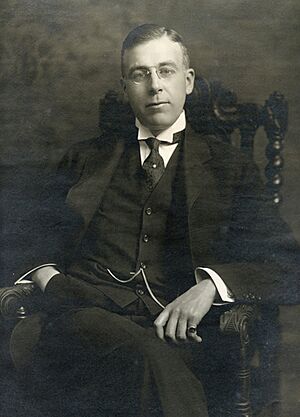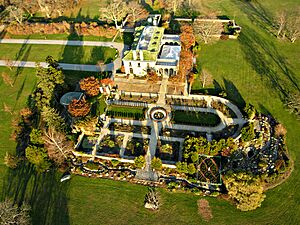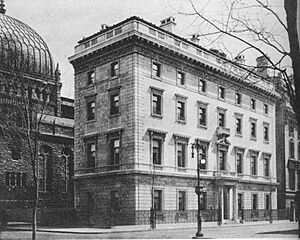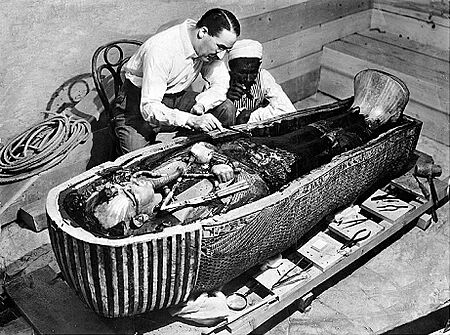Edward Harkness facts for kids
Quick facts for kids
Edward Harkness
|
|
|---|---|

Harkness circa 1912
|
|
| Born |
Edward Stephen Harkness
January 22, 1874 Cleveland, Ohio, U.S.
|
| Died | January 29, 1940 (aged 66) |
| Resting place | Woodlawn Cemetery |
| Education | St. Paul's School Yale College Columbia Law School |
| Political party | Republican |
| Spouse(s) | Mary Stillman |
| Parent(s) | Stephen V. Harkness Anna M. Richardson (Harkness) |
| Relatives | Charles W. Harkness, brother Florence, sister Lamon V. Harkness half brother |
Edward Stephen Harkness (born January 22, 1874 – died January 29, 1940) was an American philanthropist. A philanthropist is someone who gives away a lot of money to help others. Edward Harkness gave huge amounts of money to hospitals, art museums, and schools. These gifts were some of the biggest in the early 1900s.
He gave money both privately and through his family's Commonwealth Fund. He helped many famous places like Columbia University, Yale University, Harvard University, and the Metropolitan Museum of Art. He also supported schools like Phillips Exeter Academy and St. Paul's School. He even helped the University of St Andrews in Scotland.
Edward Harkness got his wealth from his father, Stephen V. Harkness. His father made a lot of money by investing early in Standard Oil. This was a very big oil company started by John D. Rockefeller. Edward also inherited money from his brother, Charles W. Harkness. In 1918, a magazine called Forbes listed him as the 6th richest person in the United States.
Contents
Edward Harkness's Life
Edward Harkness, also known as "Ned," was born in Cleveland, Ohio. He was one of four sons of Anna M. Harkness and Stephen V. Harkness. His father was a harness-maker who became one of the first partners in Standard Oil.
When Edward was fourteen, his father passed away. His mother and older brother, Charles, then managed the family's money. Edward went to St. Paul's School and then Yale College. He also studied at Columbia Law School.
In 1904, Edward Harkness married Mary Stillman. Her father was a rich lawyer in New York. As a wedding gift, Edward's mother gave the couple a beautiful new mansion in New York City. Edward chose his Yale classmate, James Gamble Rogers, to be the architect for their home. This architect later designed many buildings for Edward's charity projects. This mansion is now the main office for the Commonwealth Fund.
Edward worked briefly as a director for a railroad company. But after a few years, he decided to spend all his time on philanthropy. He started giving gifts to the Egyptian art collection at the Metropolitan Museum of Art in 1912. That same year, he joined the museum's board of trustees.
In 1916, his older brother Charles died. Charles left Edward over $80 million. This made Edward the third-largest owner of shares in Standard Oil.
Giving Back: Edward's Philanthropy
Edward Harkness gave away more than $129 million during his lifetime. This was a huge amount of money back then. Other famous givers like John D. Rockefeller and Andrew Carnegie also gave large sums.
Helping Hospitals and Medicine
Edward Harkness helped bring together Presbyterian Hospital and Columbia University's medical school. This created the Columbia-Presbyterian Medical Center (CPMC). It was the first medical center in the world that combined a hospital with a university's medical studies.
CPMC was built in the 1920s on land that Edward Harkness bought and donated. This land used to be a baseball stadium for the New York Yankees. Even though he didn't like things named after him, the Edward Harkness Eye Institute was named by his family.
Later, in 1997, Columbia-Presbyterian joined with New York Hospital. Today, it's called NewYork-Presbyterian Hospital / Columbia University Medical Center. The Harkness Pavilion, named for his father, is a key part of the campus.
Supporting Arts and Culture
Harkness was a big supporter of the New York Public Library and the Metropolitan Museum of Art. He gave money for decorative arts and helped start the museum's collection of Ancient Egyptian art. He bought the complete Tomb of Perneb for the Met. He also helped buy the Carnarvon Collection of Egyptian artifacts.
He even donated the Met's unofficial mascot, a blue decorative hippo from ancient Egypt. It's known as "William." Edward was also involved in the discovery of King Tutankhamun's tomb. He was even invited to see the opening of King Tut's sarcophagus in 1924.
Investing in Education
In 1917, Edward's mother, Anna Harkness, gave $3 million to Yale University. This money was used to build the Harkness Memorial Quadrangle student dorm in memory of Charles, Edward's brother. In 1918, Anna also started the Commonwealth Fund with $10 million, and Edward became its president.
Edward and his wife gave money for many school buildings. These include St Salvator's Hall at the University of St. Andrews in Scotland. They also helped build Harkness Chapel and Harkness Dormitory at Connecticut College. Other projects include Butler Library at Columbia University and dorms at Brown University.

Between 1926 and 1930, Harkness made big donations to his old school, Yale, and to Harvard. He wanted them to create a "residential college system." This means students live in smaller communities within the larger university. Harkness liked how colleges worked at Oxford and Cambridge in England. He offered to fund a similar system at Yale to help with overcrowding and make student life more friendly.
When Yale didn't accept his offer quickly, he went to Harvard with the same idea. Harvard's president, Abbott Lawrence Lowell, quickly said yes. With a $10 million gift from Harkness, eight houses for Harvard College were finished by 1931. Yale was disappointed and asked Harkness to reconsider. In 1930, he agreed to give Yale $11 million for nine residential colleges of its own. He also made sure his friend James Gamble Rogers was the architect for these colleges. Harkness also helped start the Yale School of Drama, the first independent drama school in the U.S.
Harkness also wanted to improve how students learned at top boarding schools. At Phillips Exeter Academy, he introduced the Harkness table method. This way of teaching uses a large oval table where students and teachers discuss topics together. This method spread to other schools like St. Paul’s and The Lawrenceville School. He also gave gifts to Taft School, The Hill School, and Phillips Academy.
He also created the Harkness Fellowships. These help people study abroad. In 1930, he started the Pilgrim Trust in the UK. He did this because he admired Great Britain and felt connected to the country. This trust helps with preserving history, supporting places of worship, and social welfare.
Edward's Homes

Edward and Mary Harkness had several homes. Besides their New York City house, they spent summers at their Eolia mansion in Waterford, Connecticut. This home and its beautiful gardens are now a state park called Harkness Memorial State Park. The Harkness family used their steam yacht, Steveana, to travel between their homes. For longer trips, they had a special train car called Pelham.
They also owned other houses in places like Long Island, North Carolina, and San Diego, California. Edward loved golf and was a member of several golf clubs.
Burial Place
Edward and Mary Harkness are buried in Woodlawn Cemetery in The Bronx, New York City. This cemetery is now a National Historic Landmark. Their family mausoleum is a grand building that looks like a small medieval church. It has a private, walled garden. The mausoleum does not have any name on it.
Edward Harkness's Legacy
Edward Harkness, along with a wealthy neighbor, inspired characters in plays by Eugene O'Neill. He is remembered for his incredible generosity and for changing how education and medicine were supported in the early 20th century.




